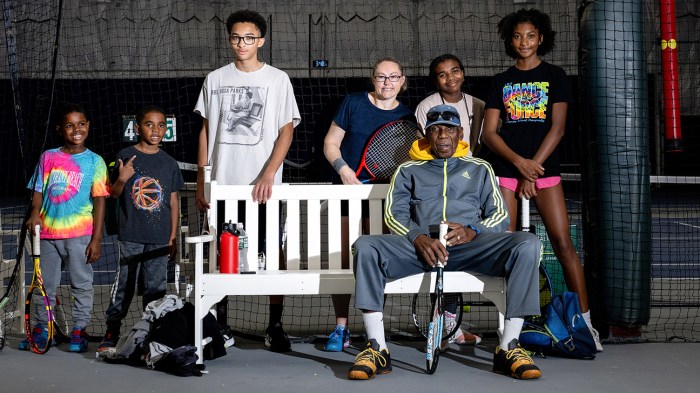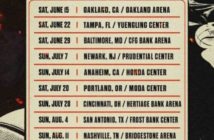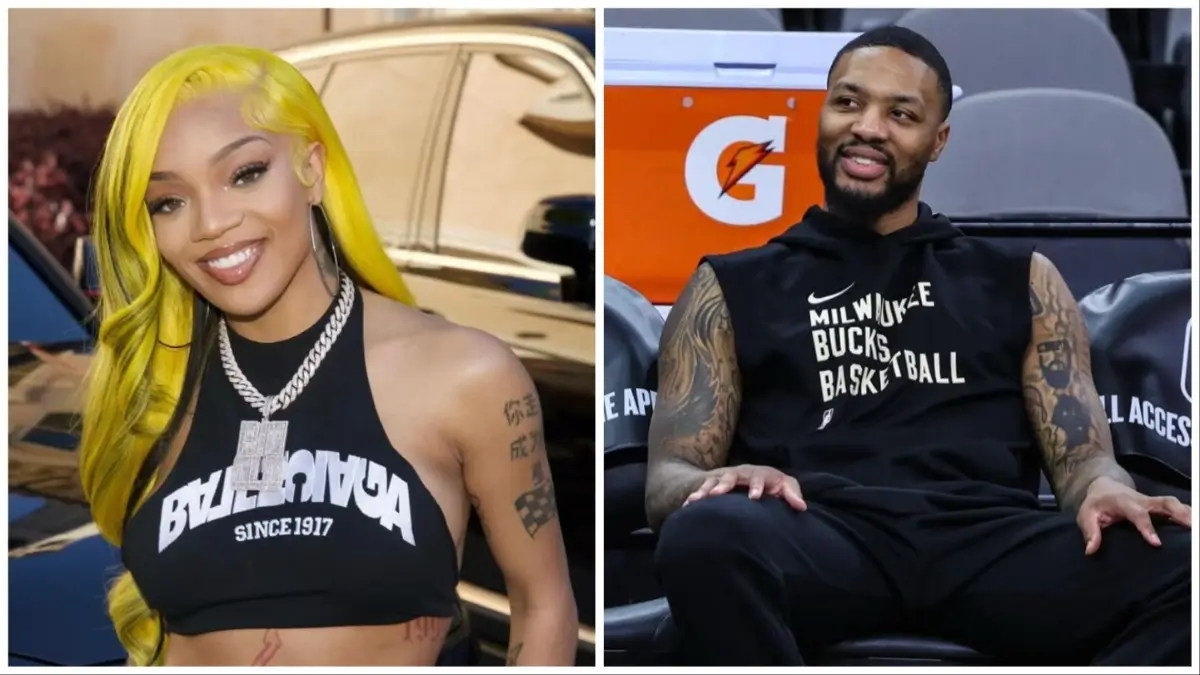HARTFORD, Conn. – I was jogging through Hartford’s Elizabeth Park recently when I happened upon Phil Gordon, a local legend who has devoted the past 50 years to teaching tennis to thousands of children – most of them from poor or working-class families.
Gordon used the sport to help them build self-esteem as well as learn composure, strategic thinking and etiquette. Many of his students took what they’ve learned from Gordon and used it to lift their families a rung up the economic ladder. His brightest pupils leveraged it into college scholarships.
We’re talking everything from small liberal arts colleges, schools such as Brown and Princeton in the Ivy League, and Power 5 schools such as Stanford, University of Southern California and the University of Florida.
Gordon is a lanky man, about 6-feet-4, who, when I ran into him just six weeks before his 80th birthday, still had a strong, athletic build. He was sitting alone in a folding chair at the tennis courts of Elizabeth Park, which is also home to America’s oldest municipal rose garden. When I approached him, sweat-drenched from my jog, he had something on his mind that had nothing to with tennis or his impressive legacy of changing the fortunes of so many families.
“They’re trying to evict me, man,” he told me, referring to the managers of the apartment building in south Hartford where he’d lived for 35 years. “Right now, I don’t have any income,” he revealed and then said something that punched me right in the gut.
“But I’m not going to leave these kids.”
Over the years, I’d seen local television news reports on his deeds, such as when he stepped up for a family with three tennis-playing kids after their mom died of cancer. I had heard about families like that of Rollo and Rochelle Jones, whose kids got college opportunities in the 1990s after working with Gordon and now their grandkids are getting the same chances.
Tennis coach Phil Gordon serves to his students during a private lesson in Bloomfield, Connecticut.
Tony Spinelli for Andscape
“Your legacy has gone on from my children to my grandchildren,” Rochelle Jones, a retired high school principal, told Gordon at an impromptu 80th birthday party held for him in November. “And they have taken what you have taught them to another level.”
But as is the case with many coaches, Gordon’s dedication and single-minded focus came at the expense of almost everything else in his life, including his finances and family. Dozens of his supporters spoke with me for this story, but his only child – and the greatest tennis player he ever coached, Alexis King – declined to comment beyond a brief note saying she and her dad have some “differences of opinion.”
There’s nothing new about the Black community embracing tennis as a way to raise up its best and brightest. We saw that with the first pioneers to make it big on the international stage: Althea Gibson was the first Black woman to win a Grand Slam championship at the French Open in 1956 and Arthur Ashe was the first Black man to win the US Open in 1968.
The first Black pro sports league of any kind was the American Tennis Association, started in 1916. Many of its finest players were developed through the support of Black community leaders such as Robert Walter “Whirlwind” Johnson, the founder of the association’s Junior Development Program, who instructed Gibson and Ashe.
“I tell people, man, I didn’t even know there were white tennis players,” said Arthur Carrington, 76, a tennis historian and a one-time ATA singles champion, who learned the game as a child at a Black-owned tennis club in Elizabeth, New Jersey. “Back in the day, with Arthur Ashe, Althea and us, we were developed in Black tennis communities.”
Gordon, though, sought to produce scholars through tennis, not pro athletes.
“Phil was taking inner-city kids, drilling them on the fundamentals of the game and aiming them at better opportunities through education,” said Michael Arace, a Columbus Dispatch sports writer who grew up in Hartford and played for one of Gordon’s teams.
The face of Tennis Unlimited
Gordon was born Oct. 18, 1943, in St. Thomas, a small U.S. territory with a population then of about 15,000. He generally waves off questions about his youth but he did confirm previous news reports that he was a ball boy at some St. Thomas hotels as a kid and he mentioned the woman who took care of him.
“My grandmother, the one that raised me, was Diana Lynch,” Gordon said, his Caribbean accent still evident. “She was a Carib Indian and we lived right the by the waterfront.”
In the Sixties, he made his way to New York City and befriended a man whose family also hailed from the Virgin Islands. That man happened to live in Hartford and brought Gordon to Connecticut, he said.
In Hartford, he found work at tennis clubs and eventually worked as a pro for an outfit that ran a club out of the Connecticut Armory in Hartford, a facility that Gordon would eventually take over in the late 1970s. He spent most of his free time hanging around the tennis courts at Keney Park in the predominantly Black North End. At the time, it had 10 pristine tennis courts. (They’re all shuttered today.)
Listen: Phil Gordon on working with young tennis players in the Caribbean.
Those courts became Gordon’s domain. He and three buddies, Black men with white-collar jobs in the schools and social services, decided to start a nonprofit called Tennis Unlimited Inc. as a way to bring an organized tennis program to Keney Park.
Lamont “Monty” Aheart was one of the founders, along with Lewis E. Randall, an educator with the city schools, and William “Bill” Brockman, a social worker, both of whom are now deceased. Before meeting Gordon, Aheart hadn’t been a tennis player but he soon had a jones for it and purchased a home across from the Keney tennis courts.
Aheart said he, Randall and Brockman focused on fundraising and administrative duties, while “Phil was the face of Tennis Unlimited.”
‘A dream come true’
Shortly after Tennis Unlimited was established, the program caught the eye of Victor Jarm, the head of Hartford’s Department of Parks and Recreation. Jarm put Gordon on payroll as a part-time employee to take Tennis Unlimited into the city’s schools.
Calvin Dees learned of Tennis Unlimited in 1978, sometime after his three sisters had started in Tennis Unlimited’s free summer tennis program at Keney Park. Dees had suffered two concussions playing basketball and his doctor suggested it was time to find a non-contact sport. At the time, he said a cousin was trying to entice him into helping him sell drugs. Instead, he picked up a tennis racket and started learning from Gordon.
“It was like a dream come true,” said Dees, who is now a tennis pro at several clubs in the area. “It was like a brotherhood. Tennis made me understand what it is to be where I’m from, to be something. Phil made it positive.”
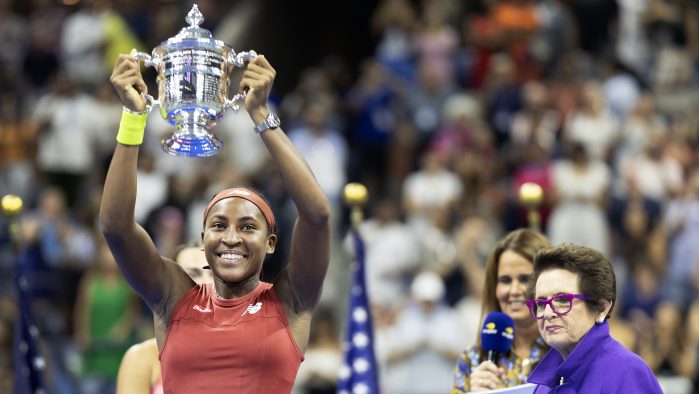 Coco Gauff has overcome self-doubt en route to the US Open titleRead now
Coco Gauff has overcome self-doubt en route to the US Open titleRead now
Gordon originally had intended that Tennis Unlimited would help Black kids but quickly realized he wanted to teach tennis to everyone from any part of the city or the suburbs. Which is how Derek Scheips, who lived in well-to-do West Hartford, began playing at Keney Park in the early 1980s. Scheips said In an email that his time spent at the Keney courts was unforgettable, as Gordon “reigned” over his popular program, which drew 40 to 50 kids to each of its sessions of summer camp.
“And it was simply a lot of fun with all that great music of the time – Rick James, Kool and the Gang, Evelyn “Champagne” King, Kurtis Blow etc. coming out of boomboxes, and people playing soccer and other sports in the fields all around,” wrote Scheips, now a professor at the University of Washington-Tacoma.
A 5 a.m. pickup
With so many kids playing, prodigies were bound to emerge.
One of the first was Timothy “T.A.” Niles, a teen who began playing with Gordon’s program in 1974.
Niles had only been in Hartford for two years. His family – his dad, mom, three sisters and a brother – had moved to Brooklyn, New York, from Trinidad and Tobago in 1971. But Niles’ mom didn’t like New York City. She packed up the children and came to Hartford, leaving her husband behind in New York.
An undisciplined student and an excellent athlete, Niles enrolled in Hartford’s Weaver High School, where he began playing basketball and soccer before deciding that team sports frustrated him. But after meeting Gordon and picking up a racket, Niles was all-in on tennis. And he was all-in on his coach, even though they both had strong personalities that led to frequent clashes. Yet there was no quibbling with Gordon’s dedication to kids from the part of town where Niles lived.
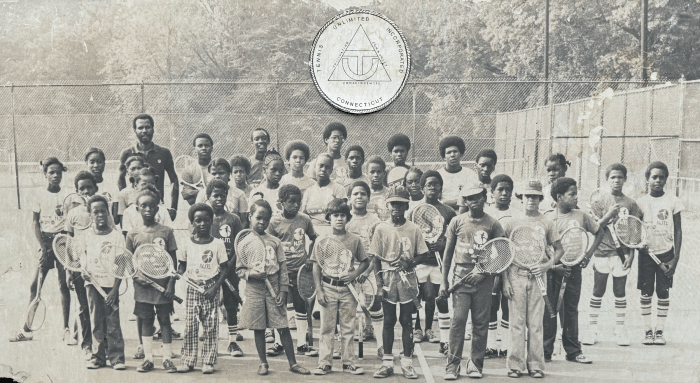 Phil Gordon (top left) gathered his summer program students in 1978 for a picture between workouts at Keney Park in Hartford, Connecticut.
Phil Gordon (top left) gathered his summer program students in 1978 for a picture between workouts at Keney Park in Hartford, Connecticut.
Phil Gordon/Tennis Unlimited Inc.
“At the time, Phil had an old convertible, I believe it was a Bonneville, and the plastic in the back was ripped,” Niles recalled. “And he’d drive around the north end of Hartford at like 5 o’clock in the morning, picking us kids up, to take us to clubs like the Canton Racquet Club, Simsbury Racquet Club – places we would’ve had no opportunity to play if it weren’t for Phil championing the cause and beating the bushes, convincing people that it would be a good idea to let us play at exclusive tennis clubs.”
Within two years of picking up the sport, Niles became Weaver High’s No 1 singles player and made the state tournament quarterfinals as a senior. Gordon wanted college to be in Niles’ future but Niles did things his way and enlisted in the Marine Corps. After nearly five years off from competitive tennis, Niles came back to train with Gordon in either late 1981 or early 1982.
By then, Gordon was running the In-Town Tennis program from the armory. He and his workers would lay down six tennis mats in the armory’s 50,000-square-foot drill hall. How was he able to get that space? Through tennis and his work with the kids, he had a network of influential allies. They included U.S. Sen. Lowell P. Weicker Jr., who would become governor, and Edythe J. Gaines, a former superintendent of Hartford’s schools and a member of several hospital boards. Several people told me that he leveraged those connections to get corporate donations, especially from the insurance companies headquartered in Hartford. (In 2020, Gordon received the Humanitarian Award from Dr. Martin Luther King Jr. Holiday Commission, Gov. Ned Lamont and the state Commission on Human Rights and Opportunities.)
This was the scenario Niles returned to – Gordon, at least for the time being, had an indoor facility and money to put on tournaments and other events.
But the coach had another message for Niles, who was in his early 20s at the time.
“I said, ‘You’ve got to go to school,’ ” Gordon was telling me one day as the two of us sat in a car he was driving on loan from the father of some of his former students. “Next thing you know, boom, he’s at the University of Hartford.”
At age 23, Niles had received a tennis scholarship from the university and would lead the Hawks to undefeated seasons in two of his four seasons while winning 80 singles and doubles matches. Niles was also a star in the classroom, graduating cum laude in 1987. After getting a master’s degree in communication from the University of Miami, he started, but didn’t complete a doctoral program at Arizona State University.
No Mickey Mouse tennis
Over the years, Gordon would tell his players that tennis is 30% physical and 70% mental. He wasn’t known for tolerating anything less than 100% effort and concentration.
“He’d say, ‘This isn’t Mickey Mouse tennis,’ ” said Andre Freeman, who learned from Gordon along with his twin brother, Seth, and their older brother Paul.
“He’s not the easiest coach,” said Matthew Lord, who spent about a dozen years with Gordon alongside his two older sisters, Dayna and Melissa. “A lot of kids thought he was too hard.”
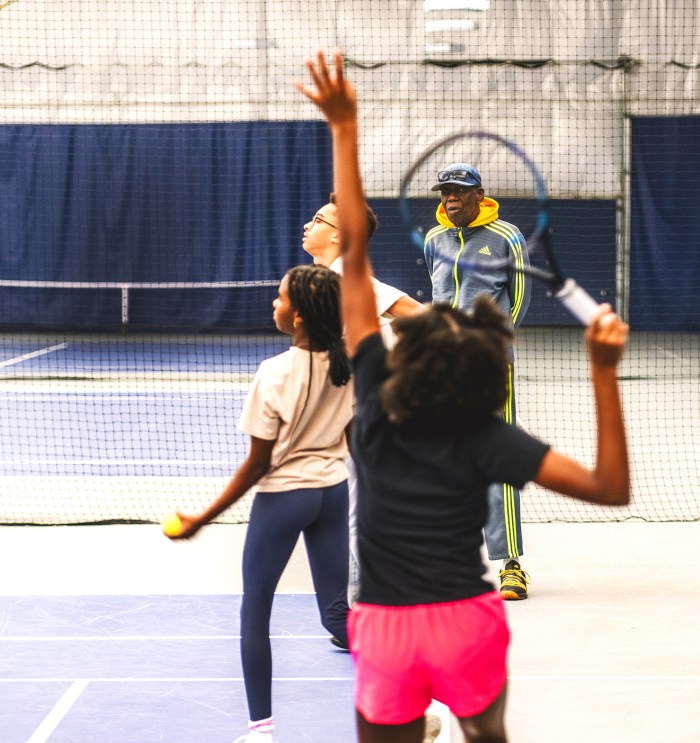 Tennis coach Phil Gordon told his players that tennis is 30% physical and 70% mental.
Tennis coach Phil Gordon told his players that tennis is 30% physical and 70% mental.
Tony Spinelli for Andscape
Matthew Lord said Gordon had a vicious bark but that “it was out of love.”
“I never took it personally because I know that maybe he’s right,” Lord said. “Maybe my shot was trash. Maybe I could have moved my feet. When I was younger I wanted to quit, but I realized that’s not what he teaches.”
Carlos Salmon Jr. did quit after working with Gordon for a few years, even though he had become one of the most highly ranked players in New England.
“His style as a coach was an animal. He was a bulldog,” said Salmon, who played under Gordon starting in the late 1990s. “It was, like, as soon as you step on the court, everything was very regimented. It was no games, no playing around. It was just you come here to work. That’s it.”
Salmon said he benefited from that approach at first but then it started to wear him down.
“I got tired of just working so hard, basically, and I needed to have quote unquote ‘a little bit more fun,’ ” said Salmon, now a self-employed financial adviser in the Hartford area. “So I ended up changing coaches. But it got to a point where I wasn’t winning. I was losing to the guys that I was practicing with and my game plateaued. I sat down with my dad and he was like, ‘Look, if you want to get better, you’ve got to go back to Phil because Phil’s going to help take your game to the next level.’ ”
And that’s what happened. He returned to Gordon, who made Salmon spend a third of his practices focusing on his serve. By the time Salmon was 16, he clocked a 142 mph serve in a national tournament in Kalamazoo, Michigan, which led coaches from Brown University and other schools to reach out.
But Salmon had his heart set on playing for USC, which had a top 5 tennis team. His guidance counselor at Windsor High School doubted he could get into USC or any of the other top schools.
“I printed out the top 10 tennis programs in the country at the time, and I said, ‘I want to go to these schools,’ ” Salmon said. “And she looked at me and she laughed. She’s like, ‘Our valedictorian couldn’t get into any of these schools. Why do you think you’re going to get into them?’ ”
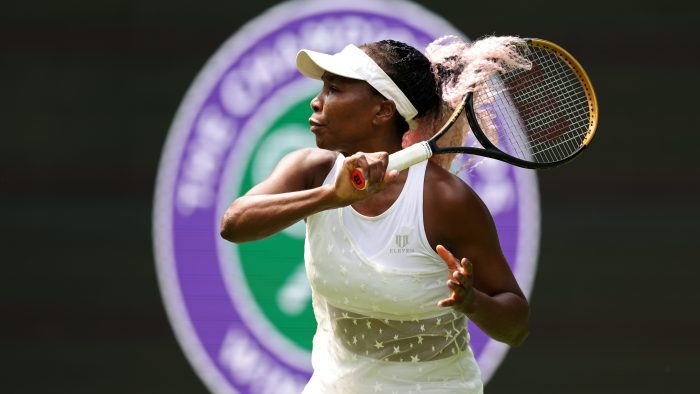 Venus Williams’ Wimbledon legacy is one of tennis’ greatest storiesRead now
Venus Williams’ Wimbledon legacy is one of tennis’ greatest storiesRead now
So Salmon took things into his own hands on the junior circuit in the summer of 2005.
“I had some good, deep runs in national events,” he recalled. “And that’s when USC was like, ‘Hey, we only have 20% [of a scholarship]left, but it’s yours if you want to come.’ So that’s how I ended up at USC.”
He played for the Trojans for a year and finished his collegiate career at Wake Forest University.
When I watched Gordon train kids in October and November, I didn’t see the tough coach with the booming bass voice that his former players had described. Maybe old age is having an effect on him. I saw him laugh and joke with some of his teenage players and high-five a 7-year-old.
We were at the Bloomfield Tennis Club, an aging-but-well-kept complex with five indoor courts. Gordon was training the five children of two of his former players, Andre and Seth Freeman, who both ended up playing small-college tennis.
Jamir, 17, and Zuri, 15, are Seth’s kids. Jada, 13, and Kyrie and Brayden, both 7, are Andre’s kids. Tricia DeLorso, 40, who works at the center, often hits with whatever group Gordon is training.
I witnessed them engage in a game called “King of the Court,” in which one person serves until their service is broken. As long as you’re serving, you’re the king. When it came time for 7-year-old Kyrie to serve, Gordon joked that he could become the youngest king ever.
Later, when Kyrie was working on hitting balls at the net as his dad Andre volleyed balls and Gordon stood watch, Gordon praised Kyrie when the boy smashed a shot back in his father’s direction.
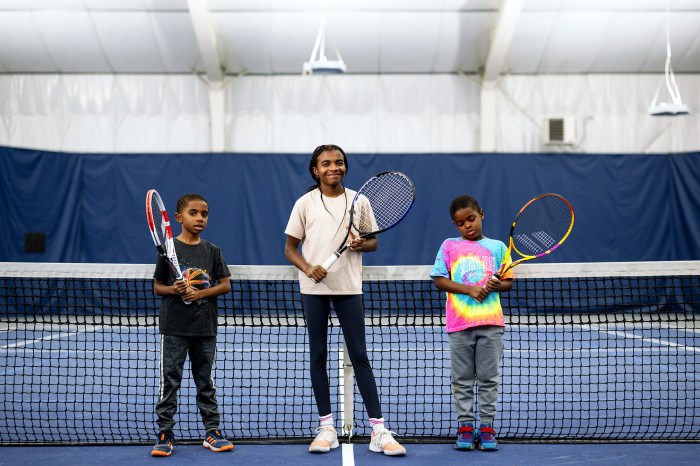 From left to right: Kyrie, Jada and Brayden Freeman are second-generation students of coach Phil Gordon.
From left to right: Kyrie, Jada and Brayden Freeman are second-generation students of coach Phil Gordon.
Tony Spinelli for Andscape
“Don’t kill your dad,” Gordon said, laughing.
Then I heard a conversation Gordon had with Kyrie and his stepbrother Brayden.
“If you get really good on the court, you won’t have to pay for college because you know how to play the game,” Gordon told the two 7-year-olds, who I wasn’t sure even knew what college was. “People will like seeing what you do and they will pay for college for you.”
He also said this:
“If you want to win, you really want to learn to do something, you really pay attention to what you’re doing,” he told the boys. “No fooling around.”
Iona Lord took her three children to Gordon on the advice of a college friend who had played in his program at Keney Park as a child.
Iona and husband Alman Lord were Jamaican immigrants with four children living in the town of Bloomfield, a majority Black area of 21,000 residents north of Hartford.
Alman was a long-haul furniture mover. Iona had worked at Aetna International as a pensions analyst. Once she started having children, she became a stay-at-home mom, and money was tight.
Their oldest child, Alman Jr., had a disability and didn’t participate in sports. The other three kids – Dayna, Melissa and Matthew – all started with Gordon as 5-year-olds, starting in 2000. Seven years later, the Lord kids were the talk of the New England juniors circuit, each of them atop or near the top of the rankings for their age bracket.
Gordon had spent so much time training them that the children came to see him as more than their coach. “He was basically our grandpa,” Melissa Lord said.
When Dayna was 12, her play caught the attention of Ron Garcia, the head girls tennis coach at Kingswood Oxford School, a private day school in West Hartford. He approached Gordon one day in 2008 when he was training the Lord kids at Elizabeth Park. Iona Lord was sitting nearby.
Gordon told Garcia to speak with her but that the conversation needed to be about scholarships to Kingswood Oxford, where middle school tuition was $30,575 a year. The two had intersecting interests: Garcia wanted his tennis team to get better. Iona Lord wanted her kids to get the type of education Kingswood Oxford provides.
The girls were admitted in 2008. Matthew would join them a few years later, but not before Nov. 27, 2010. That’s when his mother, who had been diagnosed with breast cancer, died at Hartford Hospital.
One of her final conversations was with Gordon, who she told to make sure that the children continued to use tennis to further their education beyond Kingswood Oxford and into college.
A daughter’s story
Gordon had some personal experience with the college recruitment process because his only child, Alexis, had been a sought-after tennis player in the early 2000s.
Born in 1983, Alexis was ranked No. 3 nationally in junior tennis by age 9. That ranking, notably, wasn’t in her own age group but in the division for 12-year-olds.
Long and slender like her dad, she possessed strong strokes, excellent footwork and the mental acuity to block everything else out. In the early 1990s, the United States Tennis Association invited her to Bradenton, Florida, to participate in a showcase for the top 50 girls and top 50 boys in America at any age.
The event was held at the Nick Bollettieri Tennis Academy, now the IMG Academy, and Bollettieri, the famous coach whom the grounds were named after, requested Alexis and Gordon take the court, according to Roxalina Rawls, Alexis King’s mom and Gordon’s former wife.
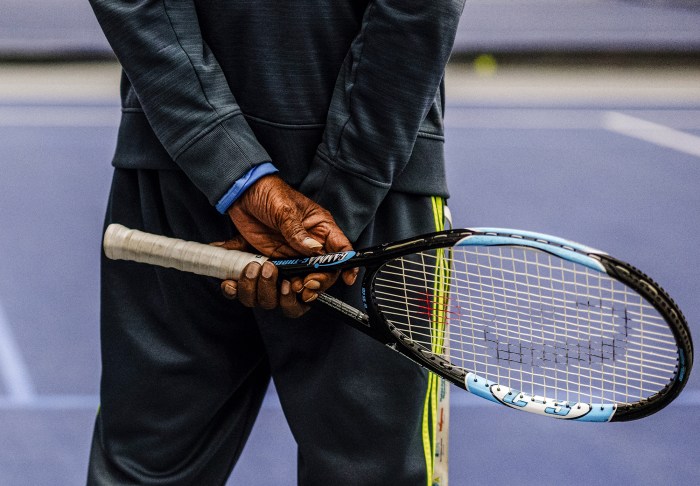 Tennis coach Phil Gordon is 80. “I don’t want to stop. I want to keep going,” he said.
Tennis coach Phil Gordon is 80. “I don’t want to stop. I want to keep going,” he said.
Tony Spinelli for Andscape
“And he said to her, ‘Show me what you got.’ And she showed him her serve, the different strokes or whatever, and Nick Bollettieri looked up at Phil and said, ‘I won’t touch too much here. Dad, you got it going.’ ”
The Gordons turned down Bollettieri’s offer for their daughter to move to Bradenton and train at the academy. But the family did have another brush with tennis royalty that week in Florida. Their daughter was asked by Richard Williams to hit with his daughters, Serena and Venus, so they would know they weren’t the only Black girls playing top-level tennis.
As she got older, Alexis Gordon trained a lot under her father alongside Maria Livadiotis, a future player at Princeton University. They would travel to a club in Longmeadow, Massachusetts, across the state border, each day after school.
“We were there for four hours every day, training,” said Livadiotis, who now lives in Cambridge, England, where she works in medical research. “And by the time we got home, it was like 9, 10, and we’d see him again the next day after school.”
Alexis King, who declined to speak to me for this story, attended the University of Florida, one of the nation’s top women’s programs, on a tennis scholarship. She was a three-time All American and was part of a team national title. She got pregnant before her senior season and took a year off from tennis to have Imani, her daughter.
Rawls said that Gordon was deeply affected by the pregnancy. “It was almost like the end of the world for him,” she said. “It was like a part of him just died. He couldn’t eat. He couldn’t sleep. He couldn’t do anything.”
Alexis Gordon went back to Florida, along with her mom, to finish school for the 2006-07 academic year. Rawls and Gordon told me that their daughter had asked her dad to move to Florida, too, where being a tennis instructor is a cottage industry. Phil Gordon said that he preferred to continue the work he started in Hartford.
Rawls said that Alexis King believes that her father’s focus “was that of a tennis coach, but not as a dad.”
Gordon told me he’s perfectly fine with his relationship with his daughter, and said he loved her very much.
After graduating college and turning pro, she won a tournament on the USTA Women’s Pro Tour in Charlottesville, Virginia.
“When she held up that trophy, everything that she had done prior came forward,” said Missy Maloof, who was the USTA tour supervisor at that event. “It was magical because I knew the struggle behind that day. And I think that’s when she – at that moment – realized that that was her Wimbledon. That was her US Open. That was her moment.”
The win moved her up to 345th in the world, the highest rank she would attain. She had married former Gator hurdler Michael King, who had become her coach. She gave birth to Maniah, her second child, in 2009.
“Just because she didn’t make it to the top 5 in the tennis world doesn’t mean she was not a complete success,” Maloof said. “In my mind, she was a complete success because she was the person that she was and she had the family that she had.”
Keeping his promise
Gordon wanted to keep his promise to Iona Lord. So he continued to work with the three Lord children nearly five hours a week, even during their high school years when they were playing tennis for Kingswood Oxford.
It paid off.
Dayna Lord lost only one match at Kingswood Oxford and was accepted into Brown University, where she played tennis for four years and left as the school’s all-time winningest female player. She worked for a few years in San Francisco after leaving Brown and now at age 28 attends the Wharton School of the University of Pennsylvania, where she is pursuing an MBA.
“We were sold on the vision and then us believing in the vision and the mission,” Dayna Lord said. “That’s kind of what propelled us and kept us moving forward.”
Melissa Lord was undefeated at Kingswood Oxford and went to Stanford University on a tennis scholarship. She was part of three national championship teams, including one in her final year, when she was No. 2 at singles. She earned a degree in public policy with a focus on science and technology policy and now, at 26, works for Plaid Inc., a digital financial services company in San Francisco. She said that her Stanford degree “makes me feel like I tied the bow with tennis a bit. Tennis is such a great sport and we all love it, but it was sort of like a cherry on top at the end of my senior year when we had that positive ending.”
Matthew Lord won 109 of his 112 matches at Kingswood Oxford and went to the University of Virginia on a tennis scholarship. He played four years at UVA and, according to coach Andres Pedroso, “was a pivotal part of a rebuilding process” that eventually led the Cavaliers to two national titles after he graduated with a degree in anthropology. Now 25, he’s a commercial real estate broker in McLean, Virginia.
Their dad, Alman Lord, remarried in 2014 and marvels at Gordon’s impact on his kids’ lives.
“It’s a one-in-a-million story,” he said when we connected on the day in October when Kingswood Oxford inducted Dayna Lord into its sports hall of fame, “because it’s not just one person, it’s three.”
The day I came across Gordon in the park, I asked him how he was planning to deal with his eviction notice. He had also told me that his electric bill, which includes heat, was $4,000 overdue. He said that “Ruth” was dealing with the rent issue and “Paul” was on the electricity issue.
Ruth Freeman is a 75-year-old retired nurse whose three sons, Paul and the twins Seth and Andre, trained under Gordon. Paul is now 47 and Ruth has assigned him to handle issues related to Gordon’s electric bill, such as seeing if the Community Renewal Team, a local nonprofit, will pay part of it and negotiating for some of it to be forgiven by Eversource, the electric company.
Ruth was handling Gordon’s living arrangements herself. In June, she applied for him to get a one-bedroom unit in a subsidized senior facility in Bloomfield, not far from the public park and tennis center where he usually teaches. Gordon had correctly told me that he had no income – not even Social Security benefits – and the seniors development only requires a tenant to pay a percentage of their income, whatever that might be, even if it’s zero.
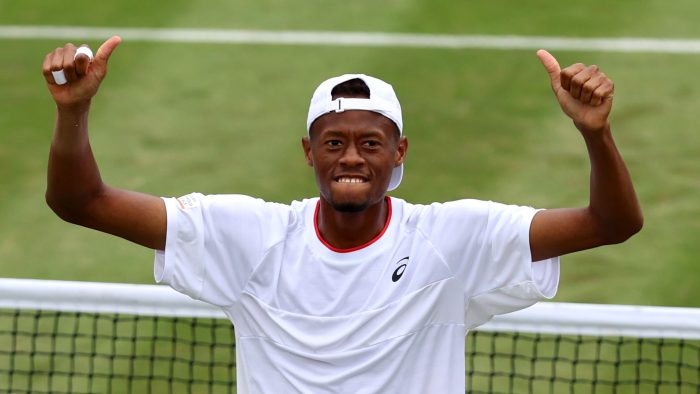 Chris Eubanks’ Wimbledon dream another beacon for Black tennisRead now
Chris Eubanks’ Wimbledon dream another beacon for Black tennisRead now
Help has come from many others as well. After Gordon’s car broke down, Alman Lord provided him with the Jeep Cherokee he now drives. Alman told me that he couldn’t stand seeing Gordon not being able to get to training.
Cynthia Lord, Alman’s wife, cooks Gordon’s food and packs it in containers so he has something to eat every day.
Monetary help has come from Alexis, as well as Carlos Salmon Sr., Andre Freeman, Rochelle and Rollo Jones, and DeLorso, the tennis center employee.
“It’s not just me,” Ruth said. “There is a community of tennis moms and dads and we all look out for him. We all want Phil to be safe and sound and the point is Phil did a lot for our kids.”
One thing his supporters couldn’t make happen was to build him his own tennis center. For the record, Gordon said he never wanted an entire academy, just a building. Niles, his former star player who graduated cum laude from the University of Hartford, put together a nonprofit to get the ball rolling in 2020. But logistical problems caused the idea to die and Niles, who is married and lives in Maryland these days, ended his efforts.
On Nov. 7, I was hanging around the tennis center when I noticed some adults show up during the time when Gordon usually trained kids.
There was an elderly man sitting at the conference table in the lobby with his eyes fixed on Gordon, who was out on Court No. 3, putting Jamir, Zuri, Jada, Kyrie, Brayden and DeLorso through their paces. Ruth introduced me to 93-year-old Guy Blais, the only white regular at the Keney Park courts in the early 1960s. He’d known Gordon for six decades.
I knew something was going on when Rollo and Rochelle Jones came through the door. Next to walk in was Carlos Salmon Sr. Seth Freeman was also in the house.
Ruth told me she had decided to have a party for Gordon, since no one had done anything three weeks earlier for his birthday. She had a cake and some cups of apple juice.
When Gordon emerged up the stairs into the lobby from the tennis floors, he was surprised to see his old friend Blais and the others and could barely contain his glee. With the young Freeman children still around, Gordon’s past and present were colliding in a happy way.
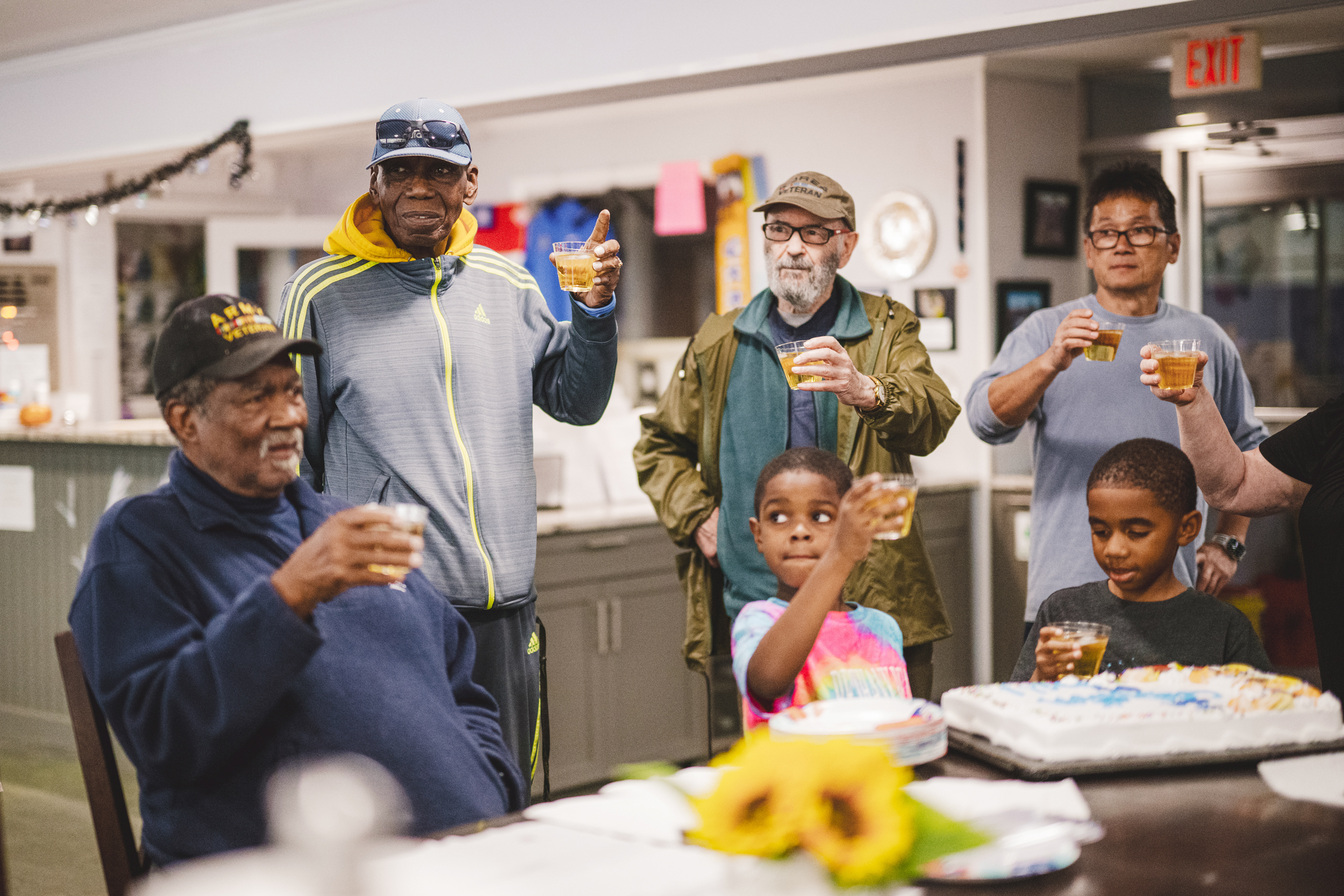 Tennis coach Phil Gordon’s longtime friends gathered together after a lesson to celebrate his recent 80th birthday with cake and drinks. Clockwise from left to right: Rollo Jones, Gordon, Guy Blais, Rick Wu, and Kyrie and Brayden Freeman.
Tennis coach Phil Gordon’s longtime friends gathered together after a lesson to celebrate his recent 80th birthday with cake and drinks. Clockwise from left to right: Rollo Jones, Gordon, Guy Blais, Rick Wu, and Kyrie and Brayden Freeman.
Ruth called the gathering to order and asked her son Seth to start it off.
“Phil, who has given so many years of instruction and mentorship and, frankly, love to myself, our family – all of our families. I want to say thank you. Phil, we appreciate you. I want to celebrate and say we love you.”
Gordon took a step closer to the conference table with the cake and most of the people.
“Well, I’m happy to be here, that’s for sure,” he said. “And I hope that the great Lord keeps me here for the rest of ever so I can do more. See, that’s the whole situation. I don’t want to stop. I want to keep going.”
“Amen,” Rochelle Jones said.
Rollo Jones told a story about the first time he’d brought his daughter Rolanda and son Rollo Jr. to Keney Park. “I said, ‘I’ve got two kids here. Can they be a part of your program?’ He said, ‘Can they play?’ I said, ‘No.’ Phil said that’s all right. They’ll learn.”
Almost a week after the celebration, Ruth sent me a text. She had been worried there would be a lengthy wait to get Gordon into the senior-living facility, after all. But he had been approved and could move in at the end of November.
A day later, on Nov. 14, Ruth met with the staff at Gordon’s new digs. She was talking to two employees there and about to leave when a third person, Yvette Moore, the resident services coordinator who plans activities, entered the room. She wanted to know the name of the new resident.
Moore was told his name is Phil Gordon. A smile creased her face. “When I was 9 years old, my mother brought me to Keney Park to Phil’s program,” she said.
